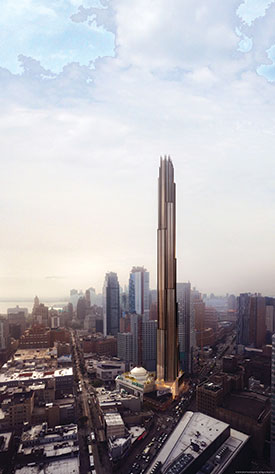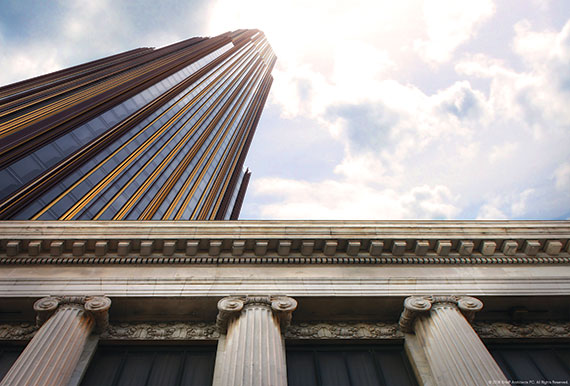Trending
Brooklyn’s new beauty
SHoP delivers ‘stunning’ supertall at 9 DeKalb for JDS and Chetrit

The Academy Award-nominated “Brooklyn” is, among other things, a sign of the times. It was quite apparent to the producers of this film, which celebrates the borough almost to the point of mythology, that the mere allure of its name would be a strong enough draw to entice moviegoers worldwide. And, in another instance of the power of the borough’s image, in the more rarefied precincts of the French capital, the highest culinary praise that can be bestowed on anything these days (short of calling it French) is reportedly to declare it to be “très Brooklyn.”
It is in this context that we must consider the newly planned tower at 340 Flatbush Avenue (more commonly known as 9 DeKalb Avenue).
If the project comes to fruition as planned — at 1,066 feet tall — it will be the tallest building in the borough as well as the tallest one in the city outside of Manhattan. Designed by SHoP Architects, it will contain 500 rental apartments, 20 percent of which will be affordable, according to news reports.
The assemblage of land that the tower will mostly occupy is home to a five-story building that will be demolished. Also contributing to the tower’s footprint is part of the landmarked Dime Savings Bank, whose purchase brought with it 300,000 square feet of airspace.
The project is interesting architecturally for two reasons: the expert design (to judge from the initial renderings) and the beauty of the Dime Savings Bank, one of the finest structures in the borough. The two buildings must be considered together, since, in an odd way, they are to be formed into one project. Indeed, the developers, JDS Development Group and the Chetrit Group, are planning to link the proposed 73-story tower to a portion of the bank, which will then be converted into retail space.

A rendering of 340 Flatbush Avenue
The developers are planning to demolish two of the banks’ annexes, a move that the local community boards and the city’s Landmarks Preservation Committee seem to be willing to accept. In fact, the local boards, which ordinarily try to rein in new developments, seem to be astonishingly amenable to this project. That’s despite the fact that 9 DeKalb represents a new and supertall frontier for Brooklyn’s residential development. We are now witnessing that trend spectacularly on 57th Street, where JDS and SHoP are also teaming up on the supertall and super skinny 111 West 57th Street.
The Dime Savings Bank structure, which ceased to function as a bank in 2002, was designed by Mowbray & Uffinger in a Classical Revival style and then greatly enlarged in 1931 by Halsey, McCormack & Helmer, who also designed the landmarked Williamsburgh Savings Bank Tower. A lovely and overwrought wedding cake of a building, the Dime Savings Bank sits elegantly on its triangular corner site with a four-columned portico behind which rises a domed structure modeled on the Pantheon in Rome. The order of these columns is fastidiously ionic, and that order is continued along the colonnades on the sides, which, like the rest of the building, are decked out in gleaming white marble. The predominant aesthetic impulse in America at the beginning of the 20th century, when construction started on the structure, was known as the City Beautiful Movement. And in New York City — and certainly in Brooklyn — there may be no more eminent example of this style than that bank.

SHoP’s team, from left: Coren Sharples, Gregg Pasquarelli, Christopher Sharples, William Sharples and Kimberly Holden
But the main part of the development, of course, is the new skyscraper, which presents us with the paradox of the skyscraper as a building type. The skyscraper originated to derive the greatest value from scarce, small plots of land. But that means that the very circumstances that call for skyscrapers to exist also make it impossible for us to see them in full — or even to see most of them at any one time. And so it happens that skyscrapers work best aesthetically where they are least needed, rising in isolation amid lower-lying buildings. Although that never happens in Manhattan, it will prove to be spectacularly true in Brooklyn if 9 DeKalb proceeds as planned. Brooklyn surely has its skyscrapers now, but they are few and far between, and even the tallest of them will scarcely rise to the midpoint of this latest project.
The renderings are stunning. The design’s ability to silence the usual griping that reflexively erupts in the face of any large development in the city speaks directly to that fact. Indeed, Brooklynites seem downright eager to see it built.
The most striking thing about the new building will be its thinness. This prodigious thinness, although fairly new to the construction industry, has recent precedents in Manhattan, but it is entirely unprecedented in Brooklyn.
The principle conceit of the new project is that it consists of an irregular patchwork of zones, whose color and hue shift according to the cladding — whether black granite, stainless steel, bronze or stone. The building’s surface appears to be configured to resemble flanges that protrude and shoot in one uninterrupted surge all the way from the structure’s base to its summit. In fact, these flange-like forms seem to over-shoot the summit in such a way as to produce a fine fretted effect that recalls the Art Deco style that’s so well represented in Brooklyn’s architectural history.
The result is a truly original design that is also deeply satisfying aesthetically, at once elegant, classical and highly unusual.
SHoP has surely been busy over the past decade. The firm is responsible for, among other things, the master plan of the controversial redevelopment of the South Street Seaport area, the so-called East River Esplanade and the redeveloped Domino Sugar Factory site. It also designed the Barclays Center, a project that, although once controversial, now appears to be very well received by the locals — even if, in the eyes of this critic, it is hardly their most successful creation.
And in addition to 111 West 57th Street, it has another project in the works with JDS. That project, at 626 First Avenue, is a pair of striking — and swaying — towers, joined almost literally at the hip by an airborne bridge.
Still, it’s 111 West 57th that comes closest to 9 DeKalb. That tower, too, has a somewhat irregular, improvised shape and a surface textured with flange-like appendages. But even if it promises to be a worthy addition to the Manhattan skyline, it must yield in beauty and iconic impact to what may soon begin to rise in the borough of Brooklyn.




